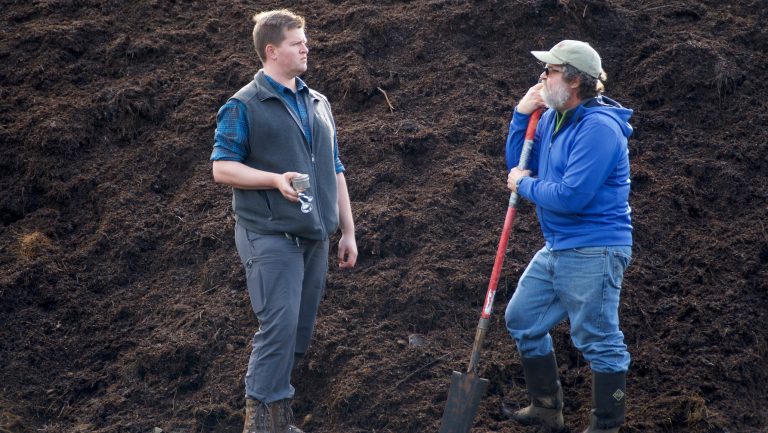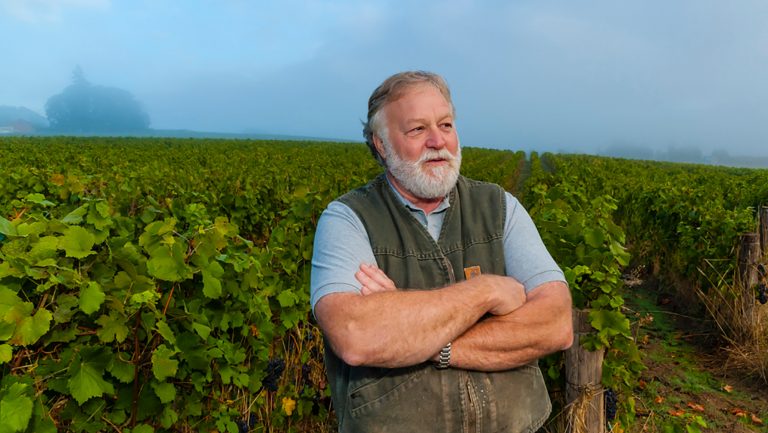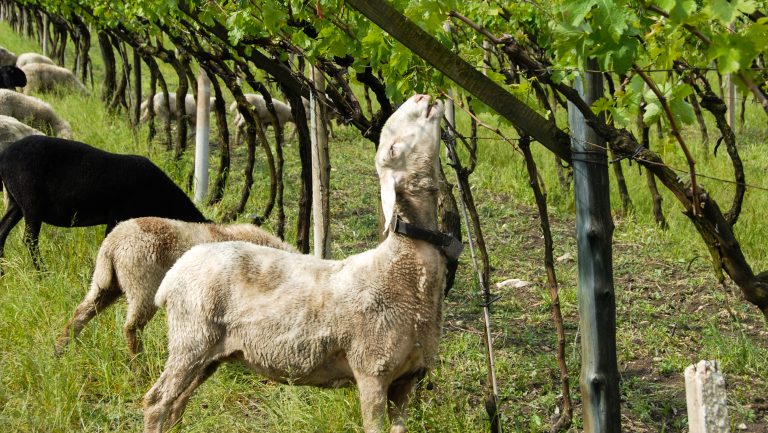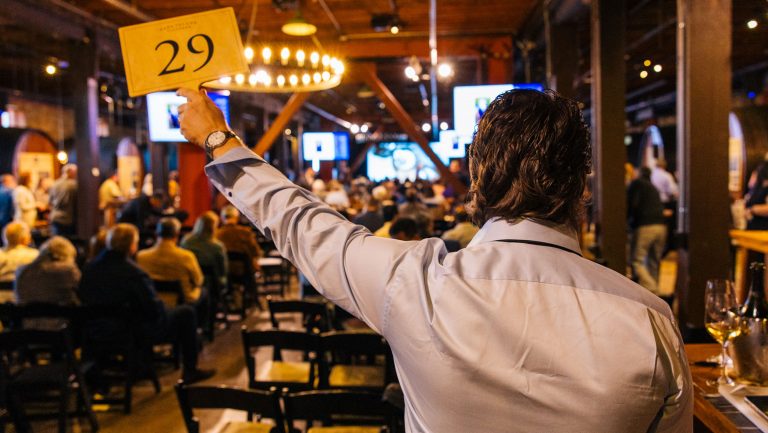Gérard Bertrand caressed a crystal singing bowl with a mallet, filling the small château on his Clos d’Ora estate with a high-pitched hum. In the vineyard beyond the picture window in front of him, a handler named Nicolas Fabrié was driving a mule, breaking up the clay soil between vine rows of Mourvèdre, Carignan, Grenache, and Syrah on nine picturesque hectares in Languedoc’s Minervois–La Livinière appellation. “Nicolas is connected to the mule,” said Bertrand, “and the mule is connected to the universe. It goes beyond biodynamics.”
It was all quite a show—the massive animal, the Tibetan instrument, the indoor-outdoor cellar downstairs that was constructed to maximize the cosmic influences on the naturally fermented wine. But though he’s prone to saying things like “We need to move from a paradigm of fear to a paradigm of love … We need to be in harmony,” Bertrand is not some hippie winemaker. He’s a businessman, and a big one at that.
As the owner of more biodynamically farmed vineyards than any other single-proprietor winemaker, Bertrand has thus far converted 600 of his total 800 hectares (roughly 1,482 acres out of 1,976) across 12 of his 14 estates to the earth-friendly method, not just because he’s passionate about it but because it yields better wine.

Don’t miss the latest drinks industry news and insights. Sign up for our award-winning newsletters and get insider intel, resources, and trends delivered to your inbox every week.
“I started with four acres in 2002 and did 50/50 conventional and biodynamic there,” Bertrand says. “The biodynamic wine was more aromatic and more balanced, with better acidity. That’s why we continued.”
Biodynamics, the agricultural method developed by the Austrian philosopher Rudolf Steiner in 1924, swaps chemical herbicides, pesticides, and fertilizers for plant, animal, and mineral preparations to support microbial biodiversity in the soil. It syncs farming with the seasons and the movements of the planets. It shapes the vineyard—and in some cases, the winery—into an ecosystem of symbiotic, living components. Some of its practices seem weird to observers, but it’s fast gaining traction because, practitioners say it works. Biodynamics creates healthy vines that yield expressive wines that speak of terroir and, not incidentally, drive sales.
It shouldn’t be surprising that larger producers would be turning to the method. Because of biodynamics’ idiosyncratic, intensive techniques, as well as the mysticism that shrouds it, the stereotype has grown of the biodynamic winemaker as a lonely soul eeking out a few hundred cases on a few acres. Yet, as Bertrand’s lead viticulturist, Gilles de Baudus, points out, “When Steiner established biodynamics in the 1920s, he was working with beet farmers of 4,000 hectares.”
After visiting Bertrand, I wondered whether the stereotype isn’t holding biodynamics back. If enough large producers go biodynamic, they could have a net-positive impact on an otherwise warming, polluted planet. What are the opportunities, as well as the challenges, in big biodynamic production? To get the answers, I spoke to some of the world’s largest biodynamic winemakers. All of them touted the benefits of scaling up, if the process is properly managed.
Start Small and Stay Flexible
“When we first started biodynamics, another Oregon winemaker said to me, ‘I can’t believe you’re trying to do it at that scale,’” says Ray Nuclo, viticulturist a King Estate, near Eugene. For Nuclo, though, the process was a relative snap. The U.S.’s largest biodynamic vineyard, with 475 of 1,033 acres of vines certified by Demeter, the international nonprofit organization that accredits biodynamic agriculture, King Estate was already organic in 2016 when it made the leap. The biodiversity and many of the practices that Demeter requires were in place. Instead of the three years the process usually requires, King Estate was certified in 12 months.
“But you don’t have to jump into the biodynamic pond headfirst,” says Nuclo. Biodynamics, in part, relies on the application of homeopathic preparations—a yarrow solution to improve soil nutrients, oak bark to combat fungus, valerian to stimulate the plants’ natural protection against frost. “But not every preparation is required every year, or x number of times a year, so you can optimize [the process] over time. There’s lots you can do to continue to improve, but you don’t have to do it all at once.”
Like Bertrand, who tested the waters before committing, Emiliana Vineyards in Casablanca, Chile, confirms Nuclo’s statement. In 1998, as part of a movement to wean Chilean farming off harmful agrochemicals, Emiliana tried biodynamics on 100 acres of its best plot.
“We released the wine in 2003 and presented it at a contest in Chile,” says Emiliana’s sustainability manager, Sebastián Tramón, “and it won all the prizes. So it was something we could believe in.” Today, with more than 1,600 certified acres, Emiliana is the world’s largest biodynamic vineyard.
But that’s not where the story ends. As Nuclo says, there’s always room for improvement, and in biodynamics, you learn by doing. “We’ve made mistakes,” says Gilles de Baudus. One big mistake, he says, is to take a one-size-fits-all approach. Because biodynamic preparations work at the level of soil microbiology, big vineyards encompassing many types of terroir must home in on the care on each parcel. Gilles de Baudus visits every plot on every Bertrand estate every other week. “I don’t have a preconceived idea of what I am going to do,” he says. “I pay attention to the soil and the needs of the vines when I’m there. It’s spontaneous.”
It’s also a lot of work, and you can’t rest on your laurels. Says the biodynamic viticulture consultant and writer Monty Waldin, the “constant evolution in you as a worker-owner and in your land, which undergoes profound change” can make the transition to biodynamics “discombobulating.” That seems especially true when a vintner is focused on other things—like business growth.
At Emiliana, where they’re gunning for 1 million cases, the biodynamic vineyards fell into a rut a few years ago. The syrah wasn’t ripening properly. There was evidence of wood disease in some vineyards. So Tramón called in the French consultant Vincent Masson, who honed in on these and other issues and tweaked Emiliana’s biodynamic treatments to address the specific problems. After careful observation of the vineyards, Masson dialed in the standard treatments—burying cow manure in cow horns to ferment it for the so-called “prep 500,” which improves soil quality; using “prep 501,” a solution of water and minute quantities of ground quartz, to stimulate growth in the vineyard—to the needs of specific plots. Emiliana’s crew learned that, in biodynamics, there are no blanket solutions. Masson’s work proved that, even for producers like Emiliana, biodynamics brings viticulture back down to earth.

Flex Your Muscles with Care
While biodynamics takes time and attention, the big guys have figured out work-arounds to the method’s classic tasks, like hand-stirring homeopathic remedies—ground quartz, yarrow, dandelion, and the like—in water the prescribed number of times, or shoveling compost piles. “We make 300 to 500 tons of compost at a time, so we use a backhoe to turn piles,” says Rudy Marchesi of the Willamette Valley’s 200-acre Montinore Estate, “and we built a special spreader with brushes instead of paddles to get an even distribution.”
Mechanization and ingenuity: Size makes them necessary, but size also makes them possible. “I look at it as more of an asset than a liability to be large,” says Nuclo. “We have more resources. We have our own shop. Whereas purchasing equipment can be expensive, we were able to fabricate our own from materials we had sitting around. We converted two old spray tanks to biodynamic prep sprayers. We made our own prep mixer. A lot of places don’t have that liberty.”
The more land you have, too, the easier it is to create the diverse ecosystem that Demeter looks for. An oak savanna and wetlands to support wildlife, farmland to raise cover crops, orchards for biodynamic cider, a sprawling kitchen garden for a biodynamic restaurant—King Estate has room for it all. Alois Lageder, a 135-acre biodynamic estate in the Alto Adige region of Italy, is ample enough to support a local cheesemaker’s herd of cows. The animals move in from October to April, grazing between the vine rows and fertilizing the soil.
Still, even operations of 100-plus acres can become overly ambitious. On the one hand, bigger producers can afford to experiment, but on the other, because biodynamics requires unique skills, says Clemens Lageder, the sixth-generation winemaker at Alois Lageder, it’s important to be realistic about capabilities. “In 2007 we made a big mistake,” he explains. “We saw that Château Pontet-Canet [in Bordeaux] was plowing with horses, so we said we needed horses as well. But we never asked ourselves, ‘How do we train ourselves to train the horses?’ When they arrived, they were massive, and we had no idea how to deal with them.”
Then there’s the big guys’ ambitions toward further growth and the problem of supply and demand. Demeter certifies farms and the grapes they grow, and separately, it certifies wineries and their wines. Grapes used for certified wines must themselves be certified. For wineries that have outgrown their own vineyards, sourcing biodynamic fruit can be tough—the farming method still accounts for just a tiny fraction of viticulture globally.
At Oregon’s Montinore, the Red Cap Pinot Noir, which accounts for 60 percent of the estate’s overall sales, was decertified because Marchesi couldn’t find enough biodynamic grapes to make 35,000 cases. He had to close the gap with organic and other green-certified grapes. “To grow,” he says, “we had to make that difficult decision. That’s reality.” On the bright side, bigger producers have capital to work with. Profits from its 70,000 total annual cases are helping Montinore finance the purchase and conversion of a new vineyard, with more to come. “So hopefully,” says Marchesi, “at some point we will get back to having enough homegrown fruit for Red Cap.”
Get Buy-In from All the Players
As Alois Lageder’s misadventure with draft horses illustrates, proper training is key to biodynamic success, and at big wineries, there are many people to train. “What’s slow is not changing the soils or plants but changing the mentality,” says Gilles de Baudus. “The explanations can sound bizarre—the moon influences the changing nature of the plants and so on—and sometimes people are skeptical.” Even as the method shows positive results, he says, “transforming intuition into conviction takes time. It’s a shock for people trained traditionally to see that biodynamics is good for a vineyard. They are convinced they know the truth, and then they start questioning themselves.”
De Baudus trained all of Bertrand’s estate directors himself, and he holds classes for employees every month. But many big producers, because they can afford to do so, hire outside consultants. At Alois Lageder, where estate grapes are supplemented by fruit from 80 small growers farming 230 acres, the family brought in an expert from Germany’s renowned Hochschule Geisenheim University to teach the contract farmers the new practice.
“We could have converted all of them quickly by paying double the price for biodynamic grapes,” says Lageder. “But it wouldn’t have worked because biodynamics is a social process. It needs time, patience, and knowledge. The biggest fear of a farmer is to lose all his yields. You need to support him. He needs to invest time and a little more money. He needs to understand his vineyard more profoundly. You need to help take away his fear.” The education—and the 10 percent more that Lageder pays for converted fruit—motivated the farmers to form a biodynamic support group. Fifteen years later, two-thirds of them are farming organically and biodynamically. “We are optimistic,” Lageder says, “that when we celebrate 200 years in five years, our farmers will be 100 percent biodynamic.”
At corporate-owned wineries especially, it’s not just the viticultural team that needs to buy in—executives must also support biodynamics. Sales and marketing must believe in it, too. In California, at the Viña Concha y Toro’s Bonterra, where 270 acres are certified, Joseph Brinkley, the vineyard director, gets everyone on board by having them get their hands dirty. “I’ve brought in our C-suite team to make preps,” he says, “and our CARE3 team [employee volunteer–led sustainability committee]. In the future, it could be our sales team and other key partners. This allows me to build a sense of teamwork and investment in the farming.”

More difficult is to sell a winery conversion to staff accustomed to manipulating juice. Even winemakers who’ve led a conversion can have a hard time with it. “I’d always loved playing with commercial yeasts, and I worried about the inconsistency of ambient yeasts,” admits Montinore’s Marchesi. “So it was hard for me to jump off that bridge.” When Marchesi finally leapt, he found little trouble with natural fermentation. “We ended up getting into how our ambient yeasts acted,” he says. “The cellar workers were giving names to different fermentations based on their different personalities.”
But biodynamic winemaking isn’t just about the adventure of native yeast; because it allows for the use of so little sulfur, it also engenders excellence. “You have to evaluate the processing so there’s not a lot of uptake of oxygen,” says Marchesi, “and you have to be attentive to sanitation—achieving that made us better winemakers.”
All the care might mean more work—or work on weekends to fit planting, harvesting, and winemaking into the biodynamic calendar. But eventually, says Bertrand, the staff sees the payoff. “At the beginning,” he says, “people said, ‘The boss is mad,’ and now they say if we go back to conventional, they will leave. It’s better for their health, and they see the positive changes in the vineyard.”
Absorb Short-Term Costs for Long-Term Gain
Of course, there’s still the matter of dollars and cents. Converting to biodynamics “costs 50 percent more, minimum,” says Bertrand. Much of that entails increased labor costs. There are also consultancy fees, the cost of equipment a winery can’t fabricate, and any preparations that have to be bought. Yet those who’ve been growing grapes this way for a while say that in the long run, biodynamic winemaking is cheaper than conventional.
“During the last two vintages,” says Nuclo, “we had less disease pressure, which is not true of Oregon as a whole. I attribute that to biodynamics. We’re saving money on the work of leaf pulling and removing infected clusters, the loss of crop, and the expensive materials we’d need to fight disease.”
Marchesi ticks off additional savings in the winery: “We’re not spending $10,000 a year on designer yeasts. We have less stuck fermentation, so the winemaking is easier. That’s also a cost advantage.”
And Lageder says, “You can’t just see biodynamics as a short-term investment. It’s much more financially efficient in the long term” than conventional farming. “The only value of soil is its fertility, and if we keep bringing in chemicals, it will lose fertility.”
Moreover, healthier soils and improved winemaking result in better wines, and those can command higher prices. Emiliana, says Tramón, has been changing its sales pyramid and pushing the high end, increasing those prices because the property has been producing better grapes that make better wines that sell more.
Another business argument can be made for the biodynamic-certified label, despite the cost and bureaucratic headache. Marchesi would have made wine biodynamically without it, he says. But Montinore acquired certification because wholesale buyers asked for it. “Sommeliers in fine restaurants want to know that you’re real,” Marchesi says. “There’s a lot of ‘greenwashing’ going on, and people don’t like being fooled. Certification is valuable for third-party verification of your practices.”
There’s evidence that retail consumers value it, too. According to Dr. Liz Thach, research conducted by the Sonoma State University Wine Business Institute in 2017 revealed that 37 percent of wine drinkers were willing to pay up to $5 more for certified-biodynamic wine.
Broadcast the Message, and Help Others Out
Big winemaking of any kind has its skeptics. “I don’t think you can make a large-scale biodynamic wine,” says Alice Feiring, the author of Naked Wine: Letting Grapes Do What Comes Naturally, “or it’s going to taste extremely conventional. There’s no one large-scale who’s going to risk any individuality on their wine.”
But the biodynamic giants, like small producers, tout the particularities of terroir and vintage in their wines. “After four years or so of biodynamics,” says Marchesi, “these flavor and aroma nuances come out that are very different and expressive. You have vintage variations, but the personality of the wines from individual blocks is more consistent.”
And if you must get big, even a doubting observer like Feiring would prefer you to do it biodynamically. “It’s not optimum,” she says, “but it’s better than conventional farming, so why not? I’d rather see big biodynamics than industrial, chemical farming—bottom line.”
Wouldn’t we all? That takes spreading the gospel. And biodynamic producers of scale are ready to use their bully pulpit. “What is most exciting for me,” says Brinkley at Bonterra, “is the opportunity to lead within this sector, to be an example. We have the capacity to share with others that biodynamic farming is viable and an intelligent business decision at all production levels.”
Part of the effort of spreading the news is the collection of data to prove the worth of biodynamics. At Emiliana, Tramón and his team are partnering with Chilean universities to conduct relevant research. “One of the big problems,” Tramón says, “is that we don’t have all the numbers to show people that this is good for the environment, the quality of the wine, the people. All of the biodynamic industry has to work on these numbers.”
Emiliana has also been sharing the wealth. This year, the winery organized a working group of Chile’s biodynamic vineyards that will meet every few months to share information and solutions. “With the power that Emiliana has because of our size and experience, it was possible to bring everyone to the table,” Tramón says. One of the challenges the group is tackling is the high cost of certification and consultancies. The idea is to pool resources so that the group can absorb the costs for smaller producers.
And Gérard Bertrand? “Because you are big,” says the winemaker, “you can influence people.” To that end, Gilles de Baudus spends at least 10 percent of his time guiding other Languedoc producers in biodynamic principles. Bertrand’s vision is that in 15 years at least 50 percent of the South of France will be organic, and the rest will be sustainable. But biodynamic? He remains realistic. “Maybe only 10 percent will be,” he says, “because it’s another step. You need to understand more than agricultural technique. You need to be connected to nature, to understand the lunar calendar, the planets. It’s a spiritual experience.”

Dispatch
Sign up for our award-winning newsletter
Don’t miss the latest drinks industry news and insights—delivered to your inbox every week.
Betsy Andrews is an award-winning journalist and poet. Her latest book is Crowded. Her writing can be found at betsyandrews.contently.com.







